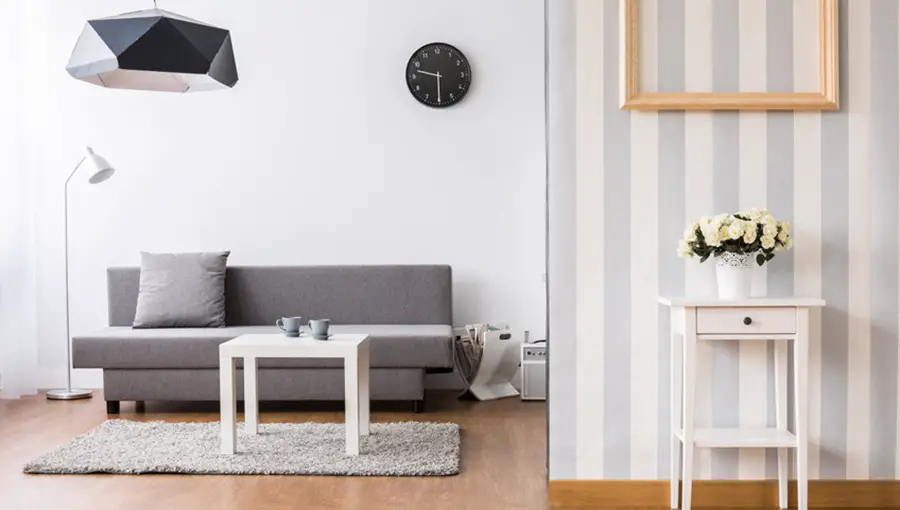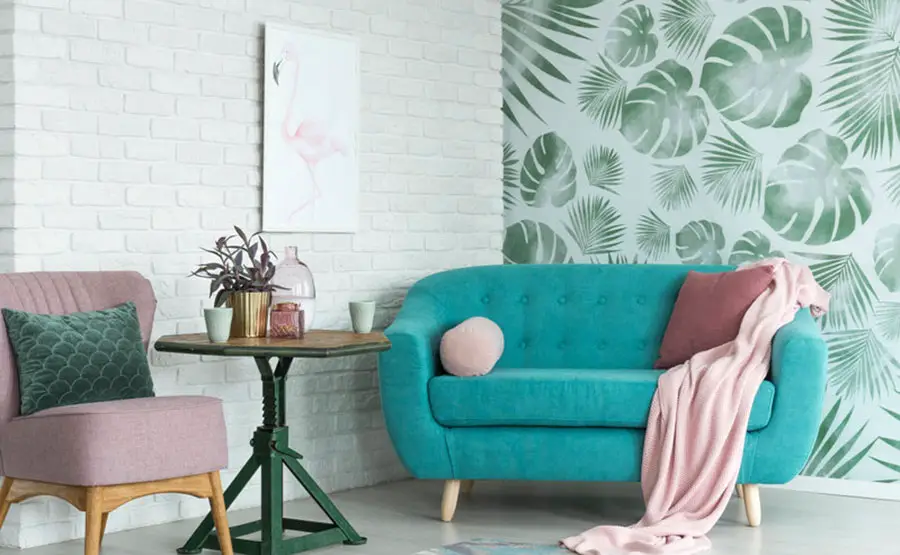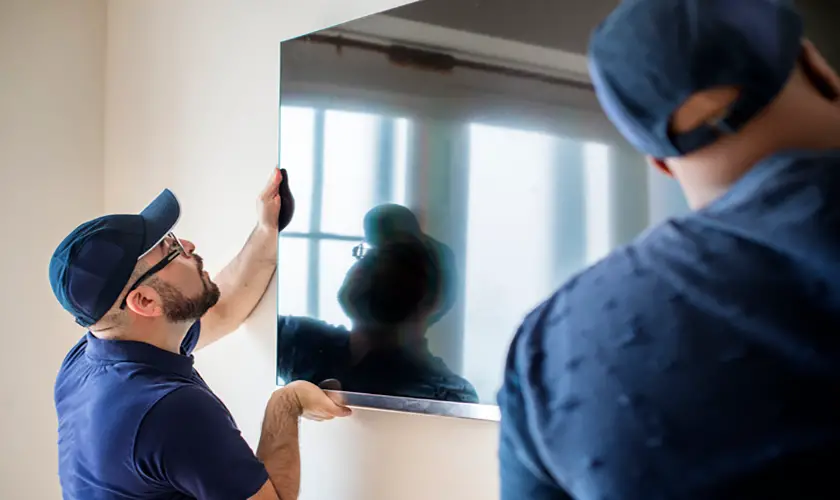
Let’s face it; sometimes, paint is just dull. If wall treatments have been on your mind lately, you may have many questions, especially when it comes to peel and stick wallpaper compared to traditional wallpaper. For instance, is peel-and-stick wallpaper any good, or should you stick to the traditional wallpaper?
For those who are cost-conscious or desire change often, peel and stick wallpaper is preferred. Peel and stick wallpaper provides easy application and clean removal if you desire a change or are just not happy with the finished look. In addition, peel and stick wallpaper is durable and can be wiped clean. Traditional wallpaper is glued down, increasing application cost and semi-permanent, lasting 15-20 years on average.
However, the answer to these questions on whether you should opt for peel and stick wallpaper or traditional wallpaper is not clear. The reality is that many factors will affect your selection. These include:
- The cost of peel and stick wallpaper vs. traditional wallpaper
- The wallpaper material used
- The installation and removal of peel and stick wallpaper vs. traditional wallpaper
- The durability of peel and stick wallpaper vs. traditional wallpaper
- The design variations and effects with peel and stick wallpaper vs. traditional wallpaper
Once you consider the available factors then compare them to your preferences, then you can decide. Therefore, you should think carefully about each one so you can choose the right kind of wallpaper for your needs.
Wallpaper Cost Comparison: Peel and Stick or Traditional
Your wallpaper cost matters. If you cannot afford to buy enough to apply on the surface you want to cover, then you will run out of material in the middle of the project. And your wall will look incomplete.
For that reason, you should research how much it will cost you to buy enough wallpaper for your design project. Peel and stick wallpaper is cheaper to install than traditional wallpaper, with costs star $1 per square foot. You can expect traditional wallpaper to cost at least $33 per square foot, including professional application.
Peel and stick wallpaper
Usually, the peel and stick wallpaper tend to be a bit cheaper than the traditional version. It will cost you as little as $1 per square foot, making it affordable even when you have a minimal budget.
Also, the surface area you intend to cover will affect the pricing. To ensure your wallpaper is enough, try to get at least 10% more than the total area covered. That extra material may end up being consumed by the trimming. It will also take care of any mistakes you make when applying up the wallpaper.
When considering the cost of wallpaper, you also need to think about the labor costs. However, you can install the peel and stick wallpaper yourself, so you don’t have to pay anything. It’s great for DIY project enthusiasts.
Traditional wallpaper
However, the traditional wallpaper is much harder to remove and install, which means you may have to hire a professional to do it for you. And that will cost you money. In the end, when you factor in both the labor and materials, the average cost of traditional wallpaper could be anywhere from $33 to $74 per square yard.
What should you choose?
For this reason, if you have little money, then stick to peel and stick wallpaper. It is much better for your needs because it is affordable. However, if you have a big budget, then get the traditional wallpaper of your dreams if you want to.

Materials Used in Peel and Stick Wallpaper & Traditional Wallpaper
If you worry about the kind of materials you use when decorating, it becomes serious when choosing wallpaper for your home.
Peel and stick wallpaper
Typically, peel and stick wallpapers are made of vinyl. But some are also made of fabric. Vinyl is relatively durable and water-resistant. That means you can wash these kinds of wallpapers if they get dirty.
Traditional wallpaper
Traditional wallpaper, on the other hand, is made of a much wider variety of materials. These include paper, fiberglass, and fabric, among others. Some are more wear- and water-resistant than others. But regardless of your preferences, you are more likely to find what works for you even when you are very conscious of the environment.
What should you choose?
So, if you are not picky about what materials you want to use to decorate your surfaces, the peel and stick wallpaper is the way to go. However, if you prefer a wide variety of materials to choose from, traditional wallpaper is more suitable for your needs.
Peel and Stick & Traditional Wallpaper: Installation & Removal Comparison
The kind of wallpaper you choose for your space will determine how many headaches you experience when installing and removing it.
Peel and stick wallpaper
So, is peel and stick wallpaper good concerning how it’s installed and removed?
The simple answer is yes!
It all boils down to the way the peel and stick wallpaper has been designed. This product is more of a big sticker. It consists of vinyl paper and an adhesive backing. Once you decide where you want to place it, you quickly remove the backing and stick the wallpaper. And if you are unhappy with what you see, you can unstick it and stick it again elsewhere.
Because of that, you don’t need to hire any professional to do the installation for you. You can also remove the wallpaper easily when you don’t want it anymore, which makes it convenient to use.
Traditional wallpaper
Unfortunately, the same cannot be said about traditional wallpaper. Instead, you need a special paste to apply the wallpaper to the wall.
Also, you cannot apply all the glue at once. You can only use the paste on smaller sections of the wall, place the wallpaper panel, and then apply it to the next section. That’s because the paste tends to dry with time, thus making it difficult for the wallpaper to adhere to the wall.
There is a technique to applying the paste to the walls and placing the wallpaper on it. First, you may need to clean up the walls and then fill in uneven surfaces. You must also have the right tools, including gloves, to protect your hands. Additionally, you must also know how to spread the paste on the walls evenly.
If you have no idea how to apply the glue, you could end up with air bubbles that make the surfaces appear uneven. That would be a waste of your wallpaper. In addition, the moisture that ends up being trapped behind the paper could also damage your walls in the long term.
Removing traditional wallpaper can also be a huge nightmare. You need to have the right chemicals and tools to strip off the wallpaper. And the entire process can take days!
You can use a liquid stripper to get rid of the wallpaper. But ensure you follow the manufacturer’s instructions to the letter. Stubborn patches that refuse to come off may have to be scraped off gently to ensure you don’t damage the walls.
Bear in mind that the longer the wallpaper stays onto the wall, the less absorbent it becomes. That would make it harder to strip off, and you may have to get creative. You may need to hire a professional to get rid of the wallpaper for you. Some of these professionals may use steaming to soften the adhesive between the wall and the wallpaper. Then it would become much easier to scrape it off.
Because of the difficulty in installing and removing traditional wallpaper, it is not the best option if you live in a rental property. The rental property owner could consider installing these kinds of wall treatments as damage to their property. And you may end up having to forfeit your deposit.
So, what should you choose?
You would be better off with the peel and stick wallpaper that you can quickly remove with minimal damage to the walls and other surfaces if you live in a rental. Then, when it’s time to remove it, there is no steaming, scraping, scoring, and stripping required. Instead, you peel it off and go.
However, for as long as you live there, you can customize your space and make it more attractive in a way that appeals to you. These kinds of wallpaper also come in handy if you want to stage your property. Once you sell it, you can quickly unstick the wallpaper and let the new buyers opt for something else.
If you own your own home, traditional wallpaper is worth considering. But remember that it is harder to install and remove, which means you cannot change it often.
But if you are the kind of person who likes to redecorate frequently or gets bored quickly, installing traditional wallpaper is not a good idea. However, if you are confident that you can enjoy the wallpaper on your walls for a long time to come, then traditional is the way to go.
Durability Comparison: Peel and Stick Wallpaper & Traditional Wallpaper
How long do you want your wallpaper to last? Does durability matter to you?
The longer your wallpaper lasts, the lower its costs over time will be. And that would make it an excellent investment.
Peel and stick wallpaper
The peel and stick wallpaper is designed to be easily installed and removed. So, the adhesive used is not as strong as what you would use to install traditional wallpaper. After a while, you may find that the glue loses its strength, and then the wallpaper will become unglued on its own.
Its durability will depend on the surface on which you placed it, the heat, humidity, and even exposure to direct sunlight. However, if all the conditions are ideal, and the wallpaper is left alone, it could serve you for a few years.
Traditional wallpaper
Traditional wallpaper lasts longer than peel and stick wallpaper versions. The paste applied to the wall creates a strong bond with the wallpaper, which is why it’s a nightmare to get rid of it. However, when installed expertly, traditional wallpaper can last for an average of 15 years or longer. That makes it more durable than its removable counterpart.
Another aspect of durability you should consider is whether the material you choose is scratch-resistant. Pets, especially, tend to want to scratch everything on sight, which means they may end up destroying your wallpaper when it’s still new.
What should you choose?
Vinyl tends to be scratch and tear-resistant. So any peel and stick wallpaper or traditional wallpaper made of this kind of material is likely to be more durable than fabric. Unfortunately, paper wallpaper is the least scratch-resistant, so it’s not as durable even when it’s the traditional version.
However, Fiberglass wallpaper is one of the best options available. It is tear-, scratch-, and wear-resistant. It can last up to 30 years! It is also anti-allergenic and much easier to clean. If you have pets, do consider this kind of traditional wallpaper for your home.
So, if you hate changing your decor and prefer something long-lasting, traditional wallpaper is the best option. It can last decades. However, if your stay is temporary and you need something that will only last a short time, buy peel and stick wallpaper and call it a day.

Design Needs and Preferences
Your design needs and preferences are worth considering too.
Peel and stick wallpaper
Most peel and stick wallpaper products are made of vinyl or fabric. On the other hand, traditional wallpaper also comes in fiberglass, combinations of synthetic and non-synthetic fibers, and paper. So, based on material variations alone, traditional wallpaper beats the peel and stick version hands down.
However, you also need to consider the finishes, styles, patterns, images, and textures you are going for and the functionality. The surface on which you intend to place your wallpaper matters a lot. Usually, stick and peel wallpaper works best on smooth walls with an egg-shell, satin, or gloss finish.
If you have no intention of changing your walls to have these kinds of finishes, you should avoid removable wallpaper. Otherwise, you will need to keep replacing them more often than you anticipated.
Peel and stick wallpaper is also unsuitable for spaces that experience significant fluctuations of humidity and heat. These conditions will weaken the adhesives. So, avoid sticking them in the wetter areas of the bathroom or hotter areas of the kitchen. You should also avoid placing them where they will be exposed to direct sunlight.
In transitional spaces, such as the nursery, peel and stick wallpaper is the best option. It will enable you to keep changing your wall designs as the child grows and leaves the space for another baby of a different gender.
Also, you can choose one section of your space as the focal point where you can place peel and stick wallpapers that you can keep changing over time. The latter strategy could work quite well, especially if you entertain people often.
Traditional wallpaper
In rooms exposed to sunlight or moisture, opt for the traditional wallpaper because the paste used to stick it is much stronger.
One of the major reasons people install wallpapers is to hide the imperfections on the walls. So, in high traffic areas where people keep touching the walls surfaces, you need to opt for traditional wallpaper that firmly adheres to the walls. The same also applies in spaces where your pets are likely to spend most of their time.
Suppose you want wallpaper that serves as a conversation starter in a space like the living or dining room. In that case, you can find traditional wallpaper that stands out for its uniqueness and makes a bold statement to everyone who sees it.
What should you choose?
Choosing what to go for concerning design needs and preferences depends on the kind of person you are. If you have well-defined ideas of what defines your design style and are willing to embrace it for years, then traditional wallpaper is a great option. However, if you have an eclectic design style or are not quite sure what you want to settle on, opt for peel and stick wallpaper that you can quickly change.
Final thoughts
The answer to the question: “is peel and stick wallpaper good?” will always remain: it depends. If you want something temporary to customize your home at an affordable price and easy to install and remove, the peel and stick wallpaper is the best option.
However, if you understand your design style, hate decorating, like variety, have a bigger budget, and don’t mind paying professionals to install and remove wallpaper, traditional wallpaper would be best for your design needs.







